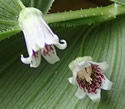Streptopus lanceolatus (Rose Twisted-stalk)
| Also known as: | Rose Mandarin, Rosybells, Sessile-leaf Twisted-stalk |
|---|---|
| Genus: | Streptopus |
| Family: | Liliaceae (Lily) |
| Life cycle: | perennial |
| Origin: | native |
| Habitat: | part shade, shade; rich, moist woods |
| Bloom season: | May - June |
| Plant height: | 6 to 16 inches |
| Wetland Indicator Status: | GP: FAC MW: FAC NCNE: FACU |
| MN county distribution (click map to enlarge): |  |
| National distribution (click map to enlarge): |  |
Pick an image for a larger view. See the glossary for icon descriptions.
Detailed Information
Flower: 


![[photo of flowers]](/udata/r9ndp23q/pd/streptopus-lanceolatus-948-26-t.jpg) Usually 1, occasionally 2, hanging, stalked flowers arising from most leaf axils. Each bell-shaped flower is ¼ to about 1/3 inch long with 6 narrow lobes that are flaring or curled back (recurved) only at the tips. Flower color varies greatly, from nearly white to deep maroon, usually with darker rose-purple spots or streaks. 6 stamens and a weakly 3-lobed style are inside the tube. The flowers are typically hidden under the leaves and may go unseen. Flower stalks are up to ¾ inch long, slender, hairy, and arching.
Usually 1, occasionally 2, hanging, stalked flowers arising from most leaf axils. Each bell-shaped flower is ¼ to about 1/3 inch long with 6 narrow lobes that are flaring or curled back (recurved) only at the tips. Flower color varies greatly, from nearly white to deep maroon, usually with darker rose-purple spots or streaks. 6 stamens and a weakly 3-lobed style are inside the tube. The flowers are typically hidden under the leaves and may go unseen. Flower stalks are up to ¾ inch long, slender, hairy, and arching.
Leaves and stems: 

![[photo of leaves]](/udata/r9ndp23q/pd/streptopus-lanceolatus-061416-2-t.jpg) Leaves are 2 to 4 inches long, ¾ to 1¾ inches wide, toothless, lance-oblong to narrowly egg-shaped with a sharply pointed tip, several prominent parallel veins, and a rounded base. Surfaces are green and hairless.
Leaves are 2 to 4 inches long, ¾ to 1¾ inches wide, toothless, lance-oblong to narrowly egg-shaped with a sharply pointed tip, several prominent parallel veins, and a rounded base. Surfaces are green and hairless.
![[photo of leaf base, stem and hairs]](/udata/r9ndp23q/pd/streptopus-lanceolatus-948-24-t.jpg) Leaf edges are fringed with short hairs. Leaves are stalkless to weakly clasping the stem. The stem is variably covered in short hairs, sometimes smooth at the base, unbranched or few branched, erect in the lower plant often arching above, and often zig-zags some between the alternately attached leaves. Plants can form loose colonies from slender rhizomes.
Leaf edges are fringed with short hairs. Leaves are stalkless to weakly clasping the stem. The stem is variably covered in short hairs, sometimes smooth at the base, unbranched or few branched, erect in the lower plant often arching above, and often zig-zags some between the alternately attached leaves. Plants can form loose colonies from slender rhizomes.
Fruit: 
![[photo of fruit]](/udata/r9ndp23q/pink/streptopus-lanceolatus-rose-twisted-stalk_0816_123122-t.jpg) Fruit is a round to oval berry ¼ to 1/3 inch in diameter that ripens to red or purple and contains many seeds.
Fruit is a round to oval berry ¼ to 1/3 inch in diameter that ripens to red or purple and contains many seeds.
Notes:
Rose Twisted-stalk, formerly known as Streptopus roseus, is found in rich woodlands and forests in about two-thirds of Minnesota. At first glance it may be mistaken for one of the Solomon's Seal (Polygonatum) species, which also have 6-parted dangling flowers from leaf axils and stalkless leaves, but also have 2 or more flowers in a cluster, pale greenish yellow flowers with petals fused nearly to the tip, blue-black fruit, and do not have a fringe of hairs around leaf edges. Also similar is Clasping-leaved Twisted-stalk (Streptopus amplexifolius), which is a larger plant, hairless, more freely branched, with greenish yellow petals that are more widely spreading. There are 3 or 4 varieties of S. lanceolatus, though these are not universally agreed upon, distinguished by rhizome characteristics and the density of hairs around leaf edges; var. longipes with long rhizomes would be found in Minnesota.
Native Plant Nurseries, Restoration and Landscaping Services ↓
More photos
 Rose Twisted-stalk plant
Rose Twisted-stalk plant Rose Twisted-stalk plants
Rose Twisted-stalk plants flower color varies greatly
flower color varies greatly flower color varies greatly
flower color varies greatly flower color varies greatly
flower color varies greatly flower color varies greatly
flower color varies greatly Rose Twisted-stalk with Clasping-leaved Twisted-stalk
Rose Twisted-stalk with Clasping-leaved Twisted-stalk Rose Twisted-stalk habitat
Rose Twisted-stalk habitat Rose Twisted-stalk with Smooth Solomon's Seal
Rose Twisted-stalk with Smooth Solomon's Seal
Photos by K. Chayka taken at Banning State Park, Pine County, Falls Creek SNA, Washington County. Photos courtesy Peter M. Dziuk taken in Cass, Cook, Pine and Washington counties.
Comments
Have you seen this plant in Minnesota, or have any other comments about it?
on: 2018-10-04 13:09:35
The first appearance was in a moist,shady spot near my garage. I dug it upthe next spring,I believe and transplanted it to a couple of other, similar spots and it’s done very well, with more stalks each year. The only other place I’ve seen it, I think, is the Eloise Butler garden. Do you know if it can be propagated by seed, and if so, how the seeds should be treated beforehand? Thanks.
on: 2018-10-04 13:27:48
Sue, almost anything can be propagated by seed. Try planting in fall, since many species require over-wintering to germinate.
on: 2023-05-10 18:11:57
Along a trail in the woods, it took me awhile to finally figure it out, that was about 2 years ago. Fun to discover a new plant and such a beauty!






